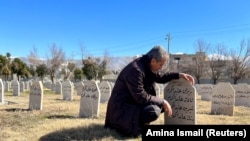March 16 marks the 35th anniversary of the most egregious case of murder by poison gas of Iraqi civilians by their own leader, Saddam Hussein.
On that day in 1988, Iraqi bombers filled the skies over Halabja, a town of some 60,000 people. They shelled the city all day, breaking windows and doors and forcing people to take shelter in their cellars. As dusk fell, and for five hours into the night, airplanes and helicopters peppered Halabja with a different sort of weapon: canisters of mustard gas, nerve agents and other chemical weapons. Heavier than air, the toxic chemicals seeped into the buildings, and crept down to where people huddled in fear.
Some 5,000 civilians died as a direct result of the toxic chemicals dropped on Halabja. Around ten thousand more were blinded, maimed, or disfigured. In the decades that followed, thousands more died from horrific health complications and debilitating diseases. To this day, the survivors of the Halabja attack suffer from increased levels of colon cancer and respiratory diseases, and high rates of miscarriages and infertility.
For decades, the Iraqi regime tried to put down restive Kurdish populations in the country’s northern provinces. The chemical attack on Halabja was part of Iraqi President Saddam Hussein’s genocidal Anfal campaign, an intensification of the attacks on the Kurds, which lasted from February to September 1988. In March of that year, Saddam Hussein put his cousin Hassan Al Majid in charge of the operation. Later that month, Iraq’s Revolutionary Command Council issued Decree No. 160, granting him a free hand in conducting the campaign.
Even prior to the Anfal campaign began, Al Majid, later dubbed Chemical Ali, decided to use chemical weapons to eliminate strongholds of resistance. In the May 26, 1987 recording of a meeting, Chemical Ali declares, “I will kill them all with chemical weapons. Who is going to say anything? The international community?”
After the fall of Saddam Hussein’s regime in 2003, Chemical Ali was tried for crimes against humanity and genocide, found guilty and executed on January 25th, 2010. The instigator of the Anfal campaign, Saddam Hussein, was found guilty of crimes against humanity and executed in 2006.
The attack on Halabja lives in infamy. The city was razed to the ground in July 1988 and eventually rebuilt. Today, it lives again, a home to nearly a quarter million people.














